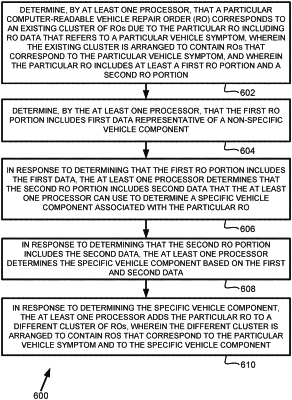| CPC G06Q 10/20 (2013.01) [G06F 16/285 (2019.01); G07C 5/00 (2013.01)] | 20 Claims |

|
1. A method comprising:
storing, within a non-transitory computer-readable memory, multiple computer-readable vehicle repair orders (ROs), a clusters database, a taxonomy terms database, a parts number database, and first meta-data that associates a particular computer-readable vehicle repair order (RO) with an existing cluster identifier, wherein:
the multiple ROs include the particular RO,
the clusters database includes multiple clusters,
each cluster of the multiple clusters corresponds to a respective cluster identifier and a respective set of RO attributes,
a cluster of the multiple clusters contains the particular RO when the particular RO is associated with the respective cluster identifier of the cluster,
the multiple clusters include an existing cluster of ROs and a different cluster of ROs,
the existing cluster of ROs corresponds to the existing cluster identifier and an existing set of RO attributes,
the existing set of RO attributes includes a particular vehicle symptom,
the different cluster of ROs corresponds to a different cluster identifier and a different set of RO attributes,
the different set of RO attributes specify the particular vehicle symptom and a specific vehicle component,
the particular RO is associated with the existing cluster identifier and specifies the particular vehicle symptom,
the taxonomy terms database contains data that identifies a plurality of first taxonomy terms each indicative of a respective vehicle component, and
the parts number database contains data that identifies a mapping of specific vehicle part numbers to particular part number descriptions,
based on the first meta-data that associates the particular RO with the existing cluster identifier, determining, by one or more processors, that the particular RO is contained in the existing cluster of ROs;
making a first determination, by the one or more processors, that the particular RO includes, within a first portion of the particular RO, a first text string representative of a non-specific vehicle component by determining that the first text string partially matches two or more taxonomy terms of the plurality of first taxonomy terms;
in response to making the first determination, the one or more processors making a second determination that the particular RO includes, within a second portion of the particular RO, a second text string indicative of a particular part number;
based on the second determination, the one or more processors making a third determination that includes inferring the non-specific vehicle component represented by the first text string is the specific vehicle component specified by the different set of RO attributes by: (i) determining, within the parts number database, a first particular part number description corresponding to the particular part number, and (ii) determining the first text string partially matches a portion of the first particular part number description, and
in response to making the third determination, moving the particular RO from the existing cluster of ROs to the different cluster of ROs, wherein moving the particular RO is carried out by: (i) revising the first meta-data so that the first meta-data associates the particular RO with the different cluster identifier and no longer associates the particular RO with the existing cluster identifier, or (ii) generating second meta-data that associates the particular RO with the different cluster identifier and revising the first meta-data so that the first meta-data no longer associates the particular RO with the existing cluster identifier.
|